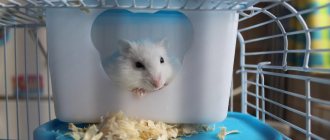- home
- Acquisition
31.03.2018
Pet breeders often face the problem of unpleasant odors. There can be many reasons for its appearance, from improper maintenance to illness of the pet. An unpleasant aroma does not depend on the size or breed of the pet; dungeon hamsters, Syrian hamsters and other species can stink.
Smell from an uncleaned cage
The first, most common one is that it is not the furry animal that has a nasty smell, but its home. If the owner of a hamster does not regularly clean his hamster’s cage, then the smell will stagnate there and not very pleasant.
Rodent owners know: healthy animals do not have an unpleasant odor . Seven days after cleaning, a specific aroma appears, which tells the hamster owner that it is time to restore order: clean and wash the rodent’s cage. It is not the animal itself that smells bad, but its excrement.
The cause of the stench is the bedding in the cage. If you use old newspapers, hay or scraps of fabric, this litter will not retain odor or moisture. And in addition to this, it can become a source of various infections, which are dangerous for both the pet and its owner.
For bedding material, sawdust or fillers are suitable: wood, cellulose or corn. Each filler or different sawdust has its own positive and negative sides. Each type has its own expiration date, during which it will absorb moisture and absorb odor. If it is not replaced after a certain time, then even the best litter will begin to emit a foul discharge.
The sawdust in the hamster's cage is changed, as a rule, every 2-4 days. If the hamster lives in wood litter, then it must be removed once every 5-8 days. If it is corn filler, then the cleaning period is once every 7-10 days.
If you choose the right filler for your furry rodent’s cage and carry out regular cleaning, then there will be no question of a bad smell in the apartment from your pet.
Source of smell
Those who breed and keep hamsters know that the problem of unpleasant odor lies solely in improper care.
Causes of odor in the cage
Many who have ever kept a hamster at home have noticed that a specific aroma appears in the cage 8-15 days after cleaning. The interval depends on the number of animals and the size of the cage. The smaller the house and the more rodents, the faster the cage gets dirty.
The smell in the cage is the result of hamster feces that accumulate over several days. The smell becomes strongest when the animal goes to the toilet in the same place at least 3-4 times.
Causes of hamster odor
There are several reasons why your hamster may produce a foul odor. Let's look at them all in more detail.
Leftover food
A common mistake that owners make is the misconception that the hamster will eventually eat the leftover food. However, this is not so - the animal is unlikely to take up stale crumbs - it will prefer to eat something fresh. Every time your pet refuses to eat the leftovers, it is better to remove them immediately so that the smell does not have time to spread throughout the house.
Bad filler
As a filler, it is necessary to avoid those materials that do not retain moisture and odor well. These include dirty rags, torn newspapers or hay. It is better to choose ordinary pressed sawdust, corn or cellulose filler.
Dirty cage
One of the most common mistakes is not cleaning the cage properly. Cleanliness in your pet's house is the key to the absence of an unpleasant odor. Ideally, you should wash and clean the cage every day, not once a week . It will not be superfluous to clean the rodent's toys and remove unnecessary scraps and scraps of paper.
Health problems
Improper care and poor food can cause a number of diseases in your animal. Vegetables containing nitrates should be excluded, otherwise your pet will experience an upset stomach and diarrhea. In addition, the hamster can pick up parasites or develop diabetes. All this causes a bad smell emanating from the rodent, and there is a serious reason to take it to the veterinarian.
Stress
Hamsters are very timid animals; they are easily susceptible to external factors that affect their mental state. An unpleasant surprise for your pet can be a new cage that does not suit him.
He may also be afraid of bright lights, loud noises, increased attention, or the presence of other animals in the house (cats, dogs). In this case, the little furry will let you know about his dissatisfaction - he will begin to mark the cage and start fights to defend his territory.
What if the hamster itself has the smell?
If your hamster smells unpleasant, then this is already a reason to worry. We repeat: the nasty stench from a rodent is not natural, since the hamster constantly cleans itself.
A hamster can emit an unpleasant odor in certain cases.
Your pet is very nervous
Maybe you recently moved or bought your rodent a new cage. Or maybe another pet appeared nearby. Even the new owner is perceived as a stranger until the hamster trusts him. He marks every centimeter of his space so that opponents know that everything here is mine! Or, by filling the place where they live with their scent, your rodent is less afraid of an unknown danger.
Some species, for example, Syrian hamsters, entering into a fight for territory, begin to exude an unbearable aroma when they are in the same cage with a same-sex representative.
In both cases, the hamster needs rest. Place the cage in a place where there are no scary odors. If there are several new animals, then you need to divide the space or move them to different cages so that the animal stops worrying.
If your new pet is afraid of you, the owner, or is afraid of a new cage, then you need to be patient until the rodent calms down on its own. Here his favorite treat from you or a few paper napkins will help him, from which the hamster will begin to build his nest.
Hamster has health problems
The animal may emit a bad odor if there are problems with its health. Any disease in a rodent can be associated with bad odors. Hamsters often suffer from diseases associated with metabolic disorders and gastrointestinal tract disorders. This may be due to poor diet, which can lead to indigestion or even poisoning.
Because of this, they become lethargic, problems with the skins begin, and an unpleasant odor appears from the animal. Your rodent may suffer from enteritis, he may have inflammation and hamsters are susceptible to diabetes.
An unpleasant odor from an animal, in the absence of a stressful situation, is a reason to pay attention to the animal’s nutrition and show your pet to a veterinarian.
Do Djungarian and other breeds of rodents really stink?
Despite all the owners' complaints, hamsters do not tend to stink, since by nature these animals are extremely clean and regularly carry out hygienic procedures. Djungarians, like other species of rodents, carefully look after their sanitary area, trying to create maximum cleanliness. They devote a lot of time to washing procedures, which is similar to cats - they are the same lovers of washing their faces and other parts of the body. Nevertheless, unpleasant odors can bother rodent owners, but they are most often caused by external reasons or the usual ill health of the pet.
What you need to remember to avoid unpleasant odors
- The pet's cage should be spacious enough. For large hamsters, the dimensions of his home should be 40 x 40 x 60 cm. For small breeds, purchase a slightly smaller, but still spacious cage 30 x 30 x 50 cm;
- use only good filler. Do not use cat litter or compressed kibble as an absorbent. Take straw or sawdust;
- The best odor absorber is corn filler. It can be changed once every two weeks. The rest, as a rule, at least once a week.
A hamster can be toilet trained!
These rodents are not only big clean people who constantly wash themselves, they are also clean in their own home. The hamster chooses a place for himself that he will use as a toilet room.
Take a closer look at where your hamster has such a place. Make your own tray for him to relieve himself. By cleaning and washing the litter box, you will save litter and clean the cage much faster.
You can take and cut a plastic bottle as a tray. To help your pet get used to the new interior detail, sprinkle a little used litter with traces of discharge on top. After a month or two, the hamster will get used to it and remember the place of its toilet.
Which breed smells less?
Hamsters themselves do not emit any odor, but your efforts to combat unpleasant odors are directly related to the size of the pet. If it is a large animal, then it will produce more excrement than a small one. This explains why the level of dirt in the cage of Syrian hamsters is higher, and they need to be cleaned more often.
It is also important to consider the length of hair in rodents. The longer it is, the more odors accumulate in it from contact with dirty filler. Even despite their cleanliness, hamsters cannot clean their long fur thoroughly enough, and this responsibility falls on the owners. This explains why Syrian hamsters' cages have to be cleaned more often.
The least problematic is keeping small rodents with short hair. These include Djungarian hamsters; such breeds are less difficult to care for.
The animal is unwell
A hamster is too small to smell when sick so that it is noticeable to the human sense of smell, and even more so - it hits the nose even when approaching the cage. In addition, the signs of the disease are quite noticeable (here, smell alone is rarely enough), and hamsters get sick at lightning speed due to their high metabolic rate. That is, a hamster cannot get sick - and at the same time have clear eyes, not inflamed or scratched skin and, most importantly, live a long time. For a hamster, we dismiss this reason as fantastic.
Something is rotting somewhere
This is clearly a problem of insufficient animal care. The hamster's house (and the cage as a whole) needs to be cleaned regularly, and the more succulent food and animal products the animal receives, the more often. If the hamster cannot eat pieces of vegetables, fruits and berries, a piece of boiled egg or cottage cheese and other delicacies at once, he will naturally put them in his house, where they will begin to rot. Therefore, as a general rule, a cage for one or two hamsters is cleaned once a week, but if you are sure that the hamster ate, as a rodent should, mainly on grains that do not spoil, then cleaning can be done a little less often, say, once every 10 days . If we have a temporary overcrowding (for example, a married couple’s offspring are growing up), naturally, we clean the cage more often than once a week.
As you can see, the simplest hygiene measures (equipment and timely washing of the toilet and regular cleaning of the cage) can turn “this terrible, smelly hamster” into a cute pet.
Food
Perishable foods are the main reason why hamsters smell bad. And it doesn’t matter whether they are Dzungarians or Syrians. Old food always gives off an unpleasant odor, and the animal should not be blamed for this. Try to give your furry only fresh food. Do not forget that this rodent of the Khomyakov family will hide it for the future, and in secluded places. Give fresh perishable foods in small portions so that they do not remain. This way you can get rid of the unpleasant odor.
Moreover, this is important for the health of the rodent itself. The rodent will transfer the remaining food to storage, where it will safely rot and decompose. Imagine - this is a real breeding ground for harmful bacteria and unpleasant odors. If a rodent eats such food, it may become poisoned, which will result in an unpleasant odor coming from the cage.
Campbell's Evil Hamster
Djungarian hamsters are one of the most beloved and popular species of rodents. Many beginners buy them to gain experience - they are very easy to maintain. But it soon becomes clear that they are aggressive - they can attack at any time, without any provocation. In this case, there is a high probability that a not very experienced (or not too honest) seller sold you a Campbell hamster.
Unfortunately, there are no breeds of hamsters that do not bite in nature - they would simply die out if they did not know how to fight back. But this cannot be said about aggressive breeds, for which it is impossible to bite a person who regularly feeds them and plays with them. And the most evil ones are Campbell's hamsters.
It is quite difficult to distinguish them - to do this you need to know several signs.
Let's start with body shapes. If you look at the jungarik from above, it resembles an egg - round and elongated. But Campbell is more likely associated with a figure eight - there is a waist, but there is a noticeable thickening in the area of the shoulder blades and hips.
The stripe running along the back is narrower in Djungarians. And in Campbell's hamsters it is wider and reaches the very forehead.
The former are the happy owners of smooth, dense fur. The second ones have more ragged fur.
How to solve a problem
We have already explained above why a hamster bites - be sure to take these tips into account to reduce the risk of repeated aggression.
You can also give several recommendations that can reduce the likelihood of getting bitten:
- Do not pick up a sleeping or sleepy hamster - if he is asleep, he may simply not understand and bite you.
- Not all rodents like it when someone puts a hand into their cage, even for games - let the hamster go out through the open door and only then pick it up.
- After touching any foods with your hands (both those your hamster loves and those with a strong smell), be sure to rinse them thoroughly - preferably without using soap or gel with a strong smell.
- Don't pick up your pet unexpectedly. Say at least a few words in advance so that he understands that you are nearby, which means that he is not in any danger.
Having taken this data into account, you will probably no longer ask the question: “What should I do if the hamster bites?”











